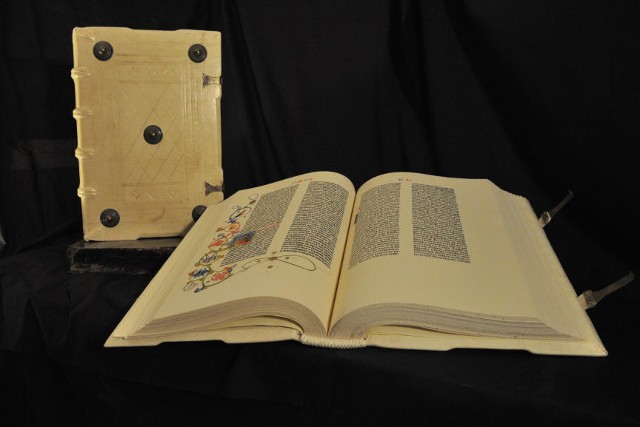|

Gutenberg Bible Facsimile 
is one of the most famous
and beautifully illuminated pages in the world.
The dramatic 15-inch-tall initial
"I" has
six miniatures depicting the six days of creation.
In the background the image of God
can be seen overlooking the work of
His hands.
The Gutenberg Bible has often been called the greatest book
in the world. There is good and sufficient evidence for the
claim. Marking the threshold of a new art form, this magnificent
work was the first major book in the west to be printed with
movable type.

The holy script was laid down using movable type
that had been cast to imitate the hand calligraphy
of the day. This Gothic style would have been
familiar to the reader and was printed in black ink.
 
To accomplish the color accents, Gutenberg left blank spaces
for the later addition of the artistic letters.
The smaller of these beautiful ornamental accents are called
rubrications, derived from the Latin rubrico,
meaning to color red (although they were also commonly
done in blue).
Once the rubrication was complete, the sheets could be
further enhanced with ornate gold work and hand-painted margin
decorations called illuminations. Margin decorations
might include religious miniatures, dragons, peacocks, falcons
and/or an array of medieval flowers.
Because each Gutenberg Bible was completed by individual
artists, no two bibles are alike. This is clearly seen by
looking at the first page of Luke's Gospel from three different
Gutenberg Bibles below.
Notice the whimsical faces hidden within the text by the
rubricator.


Printing
the Cooper Square Facsimile
 The famous Cooper Square Facsimile of the Gutenberg Bible was
issued in two volumes totaling 1282 pages. Volume I contained
648 pages and Volume II had 634 pages. It was printed on
off-white, ninety pound, one hundred percent cotton rag paper
made especially for this edition by the Curtis Paper Company. It
had a laid finish and was smooth enough to take quality intaglio
printing
The famous Cooper Square Facsimile of the Gutenberg Bible was
issued in two volumes totaling 1282 pages. Volume I contained
648 pages and Volume II had 634 pages. It was printed on
off-white, ninety pound, one hundred percent cotton rag paper
made especially for this edition by the Curtis Paper Company. It
had a laid finish and was smooth enough to take quality intaglio
printing
The 93 illuminated pages were printed via a five-color,
sheet-fed gravure, which yielded a true and careful reproduction
of the many subtle colors on the original leaves. To guarantee
richness and fidelity, each color sheet was fed through the
intaglio press seven separate times. The remaining 1189
non-illuminated pages were printed by photolithography in
three-color line to reproduce faithfully the rubrications which
enhance the black letters.

Gold was widely used within the illuminations of the original
Gutenberg Bible, but trying to replicate the same appearance
with print presented a special problem. After several
experiments, the use of a golden-bronze powder proved most
satisfactory.

In order to receive final approval, the printers needed to be
sure the gold effect would last over time without discoloration.
Tests in a tarnish machine gave rise to an innovative process to
protect the metallic powder from harmful chemical reactions by
encasing it in an undercoat and an overcoat of a special
protective lacquer.
|

